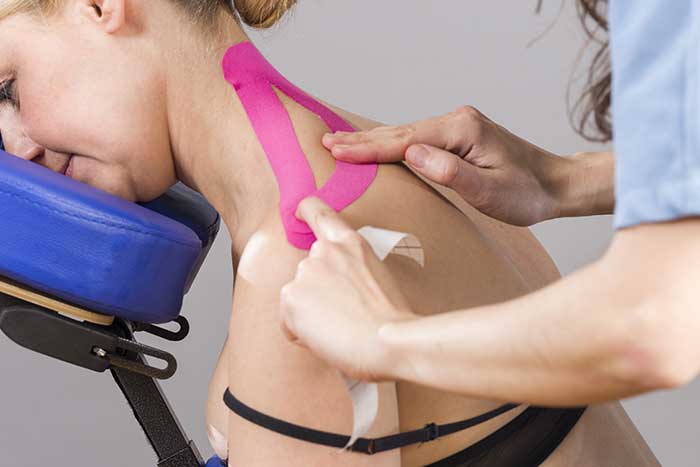Kinesiotaping in Millersville, MD
Kinesiotaping Therapy Can Improve Range of Motion
Effective Integrative Healthcare provides kinesiotaping therapy to Millersville, MD patients. Kinesiotaping is a physical therapy technique used for rehabilitation and facilitation of the body’s own healing processes. The supportive tape stabilizes muscles and joints while allowing a full range of motion for activities and quicker natural healing. To be effective, therapeutic taping should always be guided and supervised by a trained medical professional who understands your health history and anatomy to support your body appropriately with a personalized tape pattern. We have the experience to apply kinesiotape to your unique situation and give your body the extra support it needs.
What is Kinesiotaping?
Kinesiotaping is a therapeutic taping technique that alleviates pain and facilitates lymphatic drainage. Kinesiology tape is offered in pre-cut, ready-to-apply strips for different areas of the body, including the shoulder, elbow, wrist, hand, lower back, mid-back (to improve posture), neck, hip, knee, ankle, and foot. This taping offers the continuous care necessary to reduce discomfort and swelling. It also helps restore strength to an injured area and can improve your flexibility where a range of motion has been restricted. Kinesiotape is latex-free and wearable for days at a time, making it safe and popular for patients of all ages to treat orthopedic, neuromuscular, and neurological medical conditions.
How is Kinesiotaping Used?
Kinesiology tape is a stretchy tape made from a proprietary blend of cotton and nylon. This tape is designed to imitate the skin’s elasticity, so patients can maintain their full range of motion. As a medical-grade adhesive, kinesiology tape is water-resistant and durable enough to stay on for three to five days. When this tape is applied to the body, it recoils slightly and gently lifts the skin. This medical-grade tape helps create a microscopic space between the skin and the tissues underneath it. Kinesiotaping is used to create space in the joints, change signals on pain pathways, improve circulation of blood and fluids, treat injuries, support weak zones, re-educate muscles, enhance performance, and manage scars.

What Does Kinesiotape Treat?
Kinesiotape can treat muscle pain, joint pain, and ligament pain caused by various injuries, including sprains, muscle strains, subluxations, tendonitis, and more. This medical-grade tape can also reduce swelling, increase mobility, and enhance recovery. Kinesiotape provides therapeutic relief to various populations and diagnoses while aiding the body’s ability to heal itself.
The Types of Kinesiotaping
There are a handful of kinesiotaping techniques and types. The types of tape available for kinesiotaping include the classic, the performance, the gold, and the gold light touch plus. The classic tape is the original version of the tape and can be used for all applications on healthy skin. The performance tape is best for sensitive skin and when higher tensions are desired. The gold tape allows for good attachment without needing a large surface area; it’s good for low-tension applications. The gold light touch plus tape allows for a gentle grip and is usually used on children or older adults with fragile skin.
How Does Kinesiotape Work?
Kinesiotape, made with hypoallergenic acrylic glue, is manufactured to be the same weight, thickness, and elasticity as the skin and can integrate with the body’s sensory system naturally. Depending on the method of application and the therapeutic outcome desired, our physical therapy team can address three major health areas: structural therapy, neurological therapy, and circulatory therapy. Below, we’ve gone into further detail about how kinesiotape works in these significant health areas:
- Structural Therapy – Structurally, kinesiotape dynamically supports better postural positions and reduces strain on the affected muscle groups. It also prevents harmful ranges of motion without a “hard end” feel.
- Neurological Therapy – Neurologically, it promotes peripheral neuroplasticity, stimulates the internal pain relieving system of the skin, and enhances sensory stimulation that would otherwise fail to signal painful movements. Taping reinforces functional stability and restores normal muscle activation and function.
- Circulatory Therapy – In the microcirculatory system, kinesiotaping improves lymphatic flow and superficial microcirculatory flow, promoting better wave pattern formation in the body and addressing superficial fascial thixotropy or gentle muscle stretching.
The Benefits of Kinesiotaping
Kinesiotaping allows patients to reap a wide range of benefits. Not only does this tape allow the connective tissue surrounding the affected muscle, joint, or ligament to move along with the body, but it also allows the free flow of blood and lymphatic fluid. Additionally, kinesiotaping can improve circulation, support muscles, foster healing, and help prevent further muscle injury. The primary benefits of kinesiotaping include, but are not limited to, the following:
- Decreased pain
- Increased circulation
- Decreased inflammation
- Improved posture
- Improved muscle support
- Improved athletic performance
- Supported endogenous analgesic system
Kinesiotaping for Better Performance & Pain Management
Kinesiotaping impacts several areas of health and flexibility. To treat specific pain symptoms, kinesiotaping can be used for the following:
- Arthritis and bursitis
- Carpal tunnel syndrome
- Disc injuries
- Edema
- Improved athletic performance
- Muscle, joint, and ligament strains
- Plantar fasciitis
- Post-op recovery
- Shin splints
- Rotator cuff injuries
- Swelling and sprains
- Tennis elbow
Contact Us Today for Kinesiotaping Therapy
If you experience any of these symptoms or would simply like to improve your posture and comfort while working at a desk, please contact Effective Integrative Healthcare today. We’ll schedule a free consultation appointment in either our Millersville office, and together we’ll create a therapy plan across all the treatment options we offer. Contact us today to schedule a consultation with us.
